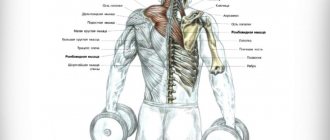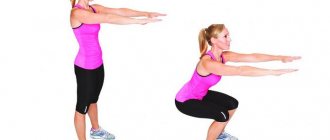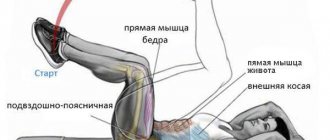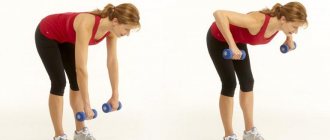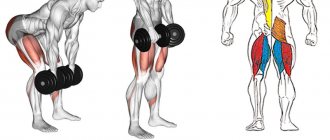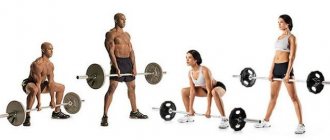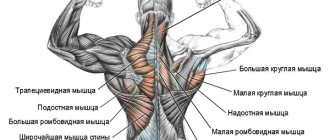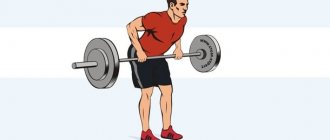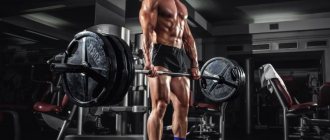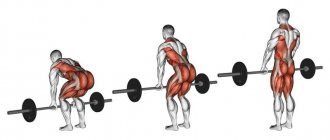The goal of most girls working out in the gym is to get round and toned buttocks. Fortunately, this is not a problem, because the number of exercises, equipment and simulators allows you to choose the right load for everyone. But not all of these exercises can be shown to everyone and not all of them bring undeniable benefits. The hyperextension machine is one of the more or less safe ones, but this version of the exercise also has its contraindications. Let's determine who is recommended for gluteal hyperextension and why, and who should avoid the exercise machine.
Benefits and features of hyperextension on the buttocks
The only difference between this technique and classical hyperextension is the rounding of the back throughout the approach. The essence of this exercise is that by rounding the back, the load on the lower back muscles is reduced, but not completely eliminated. This also does not mean that the load on the buttocks increases. In fact, the gluteal and biceps femoris muscles work with the same force as in the flat back version. It is generally accepted that this particular exercise, of all the hyperextension options, is “gluteal,” but, in fact, all of these options emphasize the load on the gluteal muscles. Only one option can reduce the load on the lower back, and the other can increase it, the same with the hamstrings. I cannot say about the unambiguous benefits of the exercise and its advantages over others in terms of the degree of development of the gluteal muscles.
What muscles are used when performing hyperextension?
Although many people perform the complex with an emphasis on the muscles of the lumbar region, it would be a mistake to believe that hyperextension is aimed only at working them out. Of course, they are the main ones, but they also participate in execution:
- Gluteal muscles;
- Hip flexor muscles.
Along with the back straighteners, these three do the main work. The secondary load, namely stabilizing the body during execution, falls on the following muscle groups:
- Rectus femoris muscles;
- Core muscles;
- Trapezius and rhomboid muscles;
- When using additional weights, the biceps and forearms are also included.
Depending on how the weight is held: on the neck and trapezius, or pressed to the chest, the main muscles involved will receive a slightly different load.
Harm and contraindications to gluteal hyperextension
The exercise can be harmful if there are contraindications in the form of a hernia of the spine, especially in the sacrococcygeal region, as well as the lumbar region, in which it is contraindicated to perform exercises with twisting of the body.
Also, hyperextension on the buttocks is contraindicated in cases of hypertension, vegetative-vascular dystonia, spinal injuries, inflammation of internal organs and in the postoperative period. Of course, the exercise is strictly contraindicated during pregnancy, just like other variations of the exercise.
With or without additional weight: which is better?
The option without weights is used, as a rule, during a warm-up to warm up the muscles before more serious exercises, for example, before deadlifting or squats with a barbell. Always warm up without weights.
If the goal of hyperextension is to work the back, and it is part of a set of basic exercises, then you should start with your own weight, and then gradually increase the load with weights. Weight is added after a person can easily, without much effort or fatigue, do three repetitions of 15 times. The first weight can be, for example, 5 kg. After you can perform three repetitions of hyperextension 15 times with this weight, you can add another 5 kg, etc.
This exercise can be easily done without a machine and even at home. However, in some variations, it will require a partner to hold your legs.
In the hall you can use a regular horizontal bench. Lie on it in the same way as on the exercise machine, face down, focusing on your hips, with your torso hanging down. The partner will hold the ankles or shins from behind. Bend your torso down and return it to the starting position.
At home, you can do this on a bed or sofa.
Hyperextension at home can also be done on the floor.
Option 1:
- lie on the floor face down;
- tear the body off the floor;
- raise and lower straight legs with a constantly raised body;
- When lifting your legs, place your hands on your lower back.
Technique for performing hyperextension on the buttocks
- Before starting the exercise, you need to adjust the design of the simulator to your own height, as well as set the inclination angle.
- Place your feet on the footrests and secure them under the bolsters.
- The pelvis should be placed on pillows, the edge of which should end under the iliac bones, so that the flexion of the torso begins from the sacrum and does not enslave the movement of the spine.
- Lower your body down, cross your arms and place them on your chest.
- Round your back, tensing your abdominal muscles, and hold this position for the entire approach.
- Exhale and lift your body, squeezing your buttocks and hamstrings. When lifting up, do not overbend your lower back, that is, the body and legs should form one line.
- As you inhale, lower your torso without straightening your back.
What to look for when choosing hyperextension
A high-quality hyperextension machine should have the following characteristics:
— the frame design is made of safe high-strength steel, not a short-lived alloy;
— high-quality synthetic leather made of hypoallergenic material should be used as upholstery material;
- the durable coating of the leg rollers should not leave bruises on the skin;
— convenient adjustment of the foot rest and tilt angle should allow people of different heights and builds to exercise;
— the simulator must easily withstand the weight of the trainee.
The reliable design of this exercise machine guarantees comfort during exercise. The upholstery leather should not slip.
The hyperextension bench should also be stable and covered with the right padding. When choosing a projectile, you need to pay attention to the presence of mechanisms for adjusting parameters. For training at home, you can purchase a folding version of the exercise machine.
Recommendations for girls and men
If the goal of the training is to focus on the buttocks, then the best way to include gluteal hyperextension in the training is to perform it after basic leg exercises. The exercise will refine and tire the buttocks, if the load was previously insufficient, as well as the hamstrings, which are appropriate to train with hyperextension after basic exercises, for example, Romanian or deadlifts.
You should not perform the exercise at the beginning of training, unlike the option with a flat back, this option will only tire the buttocks, which will be tired and “switch off” in basic exercises earlier, without fulfilling their main purpose - extension of the torso. Thus, the effectiveness of subsequent exercises is reduced.
Let me clarify that as a warm-up, you can perform a variation with a flat back in order to tone the lower back for better stabilization of the torso, for example, in squats with a barbell or deadlift.
It is not recommended to perform glute hyperextensions with additional weight, especially on the shoulders. This threatens injury to the already “broken” spine.
Optimal for muscles are 15-20 repetitions of 3 sets, until a burning sensation in the muscles.
Extensions, hyperextensions, reverse hyperextensions
There are many misconceptions and confusion regarding these exercises, ranging from how to correctly call these movements and which muscle groups perform them.
The most common misconception is that “hyperextensions” only “pump up” the lower back. By “low back” we usually mean the back extensor muscles (“erector spinae muscles”), which actually DO NOT contract during this exercise (and are also located along the entire length of the spine, and not just in the lumbar region) and work on the entire amplitude in statics, being a stabilizer. With the same success, you can “pump up” your lower back if you simply freeze for 30 seconds just below parallel to the floor; no flexion-extension movements during hyperextension affect this load, since the movement occurs (attention!) in the hip joint. If you believe biomechanics (and you should believe it), then the straightening of the torso with the legs fixed is carried out due to the hip extensor muscles: the gluteus maximus and the muscles of the posterior surface of the thigh (biceps, semitendinosus and semimembranosus). Therefore, remember, hyperextension (or extension - more on that below), like reverse hyperextension, are exercises where the key moving muscles are the gluteus maximus and the hamstring muscles. This does not cancel the work of the back extensors, but as stabilizers - in a static mode (and there is, of course, logic in training these muscles in this mode, since the safe range of flexion-extension of the spine is very small), but in your training program You should definitely take into account that the main load is received by the hamstrings and glutes, just as you take this into account when performing deadlifts or straight rows (and their variations).
Of course, you can find an old-school version of performing this movement, when the hip joint is fixed statically, and rounding (flexion) and straightening (extension) occurs in the back, then, naturally, this movement can be considered target for the back extensor muscles, but you Most likely you will never see this option in your gym. But on a fitball it’s fine (photo No. 2). Bottom line: if you want to train the back extensor muscles with hyperextensions, then it is more logical to do this simply in a static version, timing the time (and trying to increase it, as well as add weights). In this case, the hamstrings and glutes will naturally not “switch off” from working, but work in the same static mode. This will make it easier for you to ensure the progression of the load specifically for the back extensors, as well as to monitor the correct execution technique (during flexion at the hip there is a fairly high chance of “rounding” the back, especially if you do this exercise with serious additional weight). But girls, as a rule, are not at all opposed to the emphasis on the buttocks and hamstrings in hyperextensions, so the advice above will probably be useful specifically for guys who want to strengthen their back for the same squats and deadlifts. 1) Extensions or hyperextensions (photo No. 1)? Typically, “extensions” mean performing an exercise in a hyperextension machine in a relatively limited amplitude, without “hyperextension.” Thus briefly calling what is correctly called “extension of the torso in the hip joint with a fixed thigh” and implying confusion, since no one in their right mind (I want to believe this) performs this exercise by hyperextending at the lower back. Extension - translated from English as “extension” and this word can be used to describe absolutely any extension (hip, lower leg, shoulder, etc.), as, in fact, they do it in the West. Therefore, speaking about hyperextensions, I propose to still call them “hyperextensions” so as not to be confused, implying that we are talking about performing the exercise in a safe amplitude (without hyperextension). Again, in the West, there is an opinion that an error crept in and took root in the original name of the exercise: instead of “hyper” (which gives us reason to think that we are talking about “hyperextensions”) there should have been “hiper” from “hip” - hip. Everything would then fall into place, because extension occurs precisely in the hip joint. Sometimes extensions and hyperextensions are also contrasted, the first being called trunk extension, and the second - hip extension, but this is also an error caused by confusion. Hip extension is a “reverse hyperextension”, a separate exercise and we will talk about it at the very end. 2) With a straight or round back? The first myth is that if you have a straight back, then “on your back,” and if you have a round back, then on your “buttocks.” The fitness girls from Instagram again really love this “concept”. As we found out above, in both cases the movement occurs in the same hip joint, so turning the back on/off cannot be done by any magic, but the “round back” really allows you to better concentrate on the work of the gluteal muscles and hamstrings, since the static load on the back extensor muscles disappears. It simply helps you feel the target muscle groups working better. But you “pay for this” by the fact that your spine moves from a safe neutral position (with natural lordosis and kyphosis) to an unsafe one. Controlling the neutral position of the back is especially important when it comes to axial or shear loads and this load is increased due to additional weights. And if there is really no axial load in the case of hyperextension, then there is more than a shear load, so if you are going to perform this movement with additional weight, you MUST protect your back by taking and fixing a neutral position. Just like you do in straight deadlifts (Romanian), understand? Biomechanically, these exercises are very similar. You can do it with a round back when you don’t just want to “feel better” how your gluteal and hamstrings work, but do it specifically to eliminate the static load on the back extensor muscles. For example, this can be done with hyperlordosis, when this muscle group is in hypertonicity and does not need additional stimulation, but rather needs to be stretched. 3) Is it always safe for everyone? Another popular myth that makes hyperextension a “panacea” for people with back pain. They say that this exercise is a priori safe and is a universal rehabilitation exercise. I repeat, in this movement there IS a shear load on the spine, just as there is in the deadlift. Therefore, it is as safe (or NOT safe) for you as that same deadlift; the whole question is in the amount of weight. When doing hyperextensions with your own weight, you give a tonic, and not a developing (high-intensity, near-maximum) load, but as soon as you pick up a serious weight (a couple of weights) you have all the same risks that you can get when performing deadlifts or deadlifts on straight lines . Therefore, it is NOT about the safety (or danger) of the exercise, but about the type, volume and intensity of the load. For those who are very weak and at the same time heavy (with a lot of extra weight, for example), deadlifts with a body bar may be safer than hyperextension with your own weight. 4) Reverse hyperextension (photo No. 3). I really consider this exercise to be a universal rehabilitation exercise, let strict sports and fitness methodologists ask me not to make a cult out of any one movement. Correctly, this movement is called “extension of the hips with a fixed torso,” but the name “reverse hyperextension” has quite caught on, so let’s call it that. From a biomechanical point of view, the movement almost completely repeats the “hip extension in a block” or “leg abduction”, as it is sometimes called - a popular “female exercise” for accentuating the gluteus maximus. It’s all the more comical that harsh athletes who honor the westside style of training and ridicule such “pop-swings”, considering them a frivolous and unnecessary exercise, deify this very “reverse hyperextension”, which essentially repeats these same hated “pop-swings” fitness -bikini (photo No. 4). The difference is that the movement occurs with both legs at once (and not in turn), and also in the fact that the body lies on a bench (or a special part of the corresponding simulator), which removes the shear load from the spine, and also reduces the load on the muscles stomach and back. This is precisely the key advantage of reverse hyperextension (over regular hyperextension) and why I so strongly recommend it, and to make it more convenient for you to perform this movement, we ordered a special simulator that allows you to safely develop the gluteus maximus and hamstring muscles even for those who have health restrictions associated with back injuries (while the machine is still on the way, you can do it as Ksenia shows in the photo). PS Can you imagine how we can simplify all this terminology if we call “hyperextension” (extension) - extension of the torso, and “reverse hyperextension” - extension of the hips (and if with one leg, then the hip). Simple and clear.

